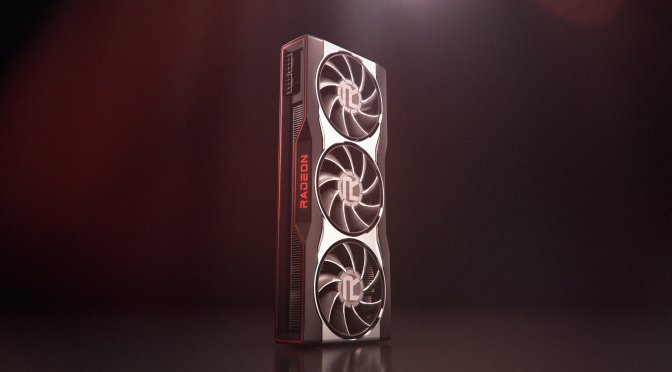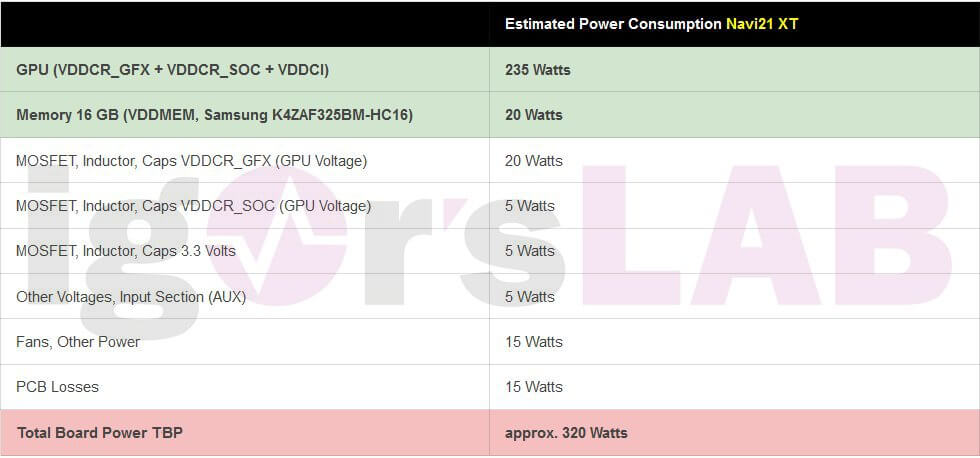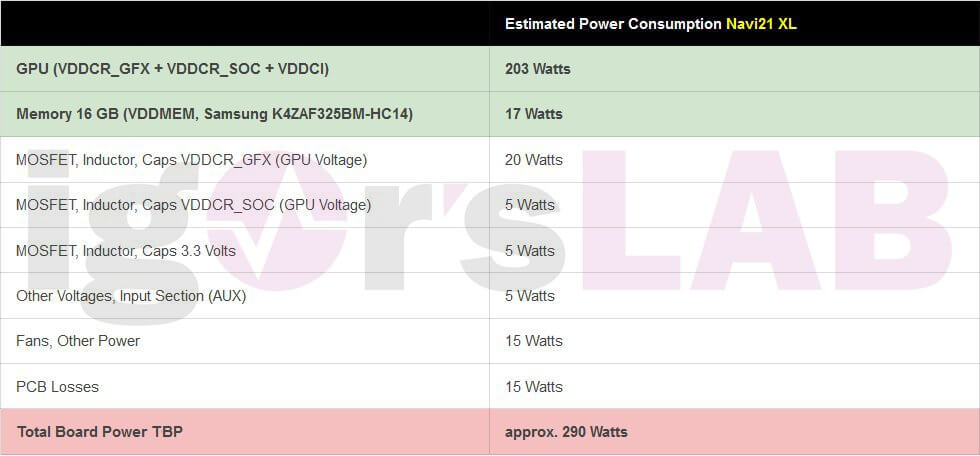It appears that we have some fresh details on the power consumption figures and memory specs of AMD’s upcoming Big Navi 21 GPU lineup as reported by Igor’s Lab. Igor Wallossek has also debunked the previous Navi 21 XT TGP value as posted by Patrick Schur.
First off, we have some information on the power consumption of AMD’s upcoming Navi 21 XT GPU variant. According to Igor the AMD Navi 21 XT will feature a TBP of around 320W, and not 255W as reported earlier by Patrick Schur. TGP stands for Total Graphics Power, whereas TBP is the total board power.
The previous TGP value was wrong since AMD calls the power consumption of the entire card as TBP (Total/Typical Board Power) while NVIDIA calls the equivalent as TGP (Total Graphics Power).
These values are not equal and do not represent the same thing for both AMD and NVIDIA. The 255 Watt TGP value reported earlier only took into consideration the GPU socket power (i.e. GFX, SOC, and VDDCI), and VRAM.
NVIDIA’s TGP figures are based on the entire board’s power consumption, which includes GPU, VRAM, VRM, fans & everything else that feeds on the power. The AMD equivalent of TGP is TBP, and according to Igor, the values reported earlier were in fact just the GPU and VRAM figures alone.
As Igor explains, in AMD’s Graphics Power ONLY the supply voltages of the GPU for the GFX controller (VDDCR_GFX) and SOC controller (VDDCR_SOC) are included as the most important component, as well as the supply voltages for the memory such as VDDMEM and VDDCI (controller and bus).
So AMD’s graphics power is not equal to Nvidia’s TGP, since that represents the power consumption of the whole graphics card. 255W was only representing the socket power of the AMD card.
Looking at the table posted by Igor the Navi 21 XT would have a stock GPU power consumption of 235W. Thus the TBP (total board power) of the entire Navi 21 XT GPU would be at around 320W. The custom AIB cards will have 355W as the TBP value.
Here is the breakdown for the Navi 21 XT graphics card SKU. 235 Watts for the GPU alone, 20 Watts for Samsung’s 16 Gbps GDDR6 memory, 35 Watts for voltage regulation (MOSFETs, Inductors, Caps), 15 Watts for Fans and other stuff, and 15 Watts that are used up by PCB and other losses found there. This puts the combined TBP value to 320 Watts.
As mentioned before, for custom AIB OC cards, the TBP value is 355 Watts since the GPU alone is using 270 Watts of power.
When it comes to the Navi 21 XL GPU cut-down variant, the cards based on this silicon will have 290 Watts of TBP, as the GPU power sees a reduction to 203 Watts, and the GDDR6 memory only uses 17 Watts.
Igor predicts that AMD should also use seven phases for VDDCR_GFX and one for VDDR_SOC in the voltage converter area, which doesn’t push the efficiency much, but is completely sufficient.
Igor has also pointed out that the Radeon RX 6000-series Navi 21 graphics card will use Samsung’s 16 Gbps memory modules. But this does not mean AIBs will only rely on Samsung memory for their custom cards.
Because AMD often bundles the GPUs together with the memory as a whole package to the AIB partners, but AIBs are free to put a different memory if they want, as long as it is a 16 Gbps module.
The Navi 21 XT will utilize the Samsung K4ZAF325BM-HC16 DRAM chips which are rated at 16 Gbps speeds giving 512 GB/s of total bandwidth, while the Navi 21 XL cards on the other hand will feature K4ZAF325BM-HC14 DRAM Samsung chips which are rated at 14 Gbps and will deliver 448 GB/s of total bandwidth.
It’s interesting that AMD only uses about 20 watts for the entire memory, which could well be an average value. Igor also talks about the availability of these RX 6000 Navi GPU variants. According to his report the first custom boards will be available around mid-November, with wider availability of SKUs expected around the end of November.
The PCB design for the Radeon Navi RX 6000-series cards is almost similar to the Radeon RX 5700 reference PCB since both feature the same bus interface, except for a beefier VRM and a better power delivery system found on the flagship Big Navi 21 board.
As Igor noted, “Cards, such as a Sapphire Nitro or Asus Strix (which in turn should only be able to withstand MLCC), are expected to be delivered in smaller, technically feasible quantities as early as mid-November, while other manufacturers will (have to) allow themselves time until the end of November.”
AMD plans to showcase its Radeon RX 6000 NAVI GPU lineup on October 28th, based on the new RDNA 2 architecture.
Join us on October 8 and October 28 to learn more about the big things on the horizon for PC gaming. pic.twitter.com/9dy8Lt5MP8
— AMD Gaming (@AMDGaming) September 9, 2020
RDNA 2 GPUs are expected to be fabbed on an optimized 7nm process node, and they will support hardware-level ray tracing as well, and are expected to deliver a 50% increase in performance per watt over previous-gen RDNA arch.
Along with an improved performance-per-clock (IPC), and logic enhancement that helps reduce the design complexity and switching power. The GPU clock speeds are also going to get a boost.
Stay tuned for more!
Hello, my name is NICK Richardson. I’m an avid PC and tech fan since the good old days of RIVA TNT2, and 3DFX interactive “Voodoo” gaming cards. I love playing mostly First-person shooters, and I’m a die-hard fan of this FPS genre, since the good ‘old Doom and Wolfenstein days.
MUSIC has always been my passion/roots, but I started gaming “casually” when I was young on Nvidia’s GeForce3 series of cards. I’m by no means an avid or a hardcore gamer though, but I just love stuff related to the PC, Games, and technology in general. I’ve been involved with many indie Metal bands worldwide, and have helped them promote their albums in record labels. I’m a very broad-minded down to earth guy. MUSIC is my inner expression, and soul.
Contact: Email




